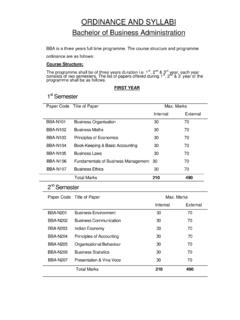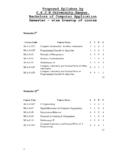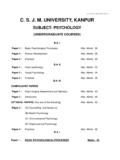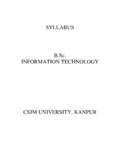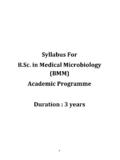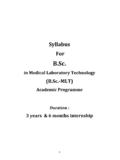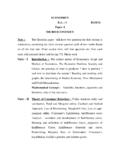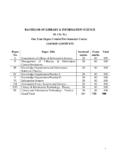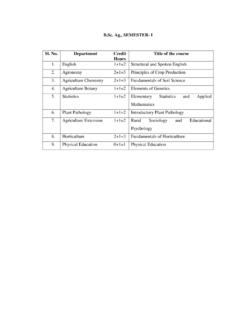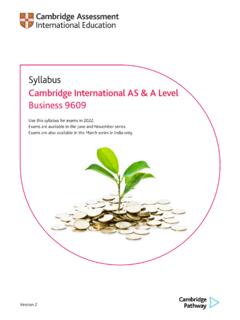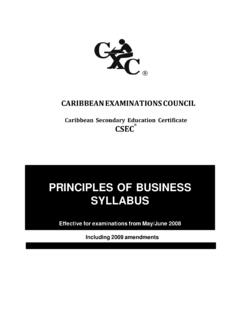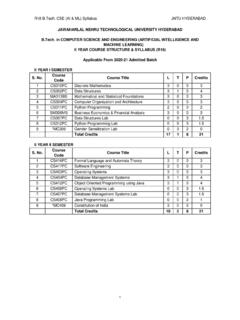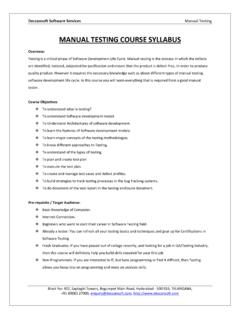Transcription of BACHELOR OF COMMERCE (B.COM-I)
1 BACHELOR OF COMMERCE ( ). COURSE INPUT DETAILS. GROUP-A: PAPER-I business COMMUNICATION. OBJECTIVE. The objective of this course is to develop effective business communication skills among the students. COURSE INPUTS. UNIT I Introducing business Communication: Basic forms of communicating;. Communication models and processes; Effective communication; Theories of communication; Audience analysis. UNIT II Self-Development and Communication Development of positive personal attitude; SWOT analysis; Vote's model of interdependence; Whole communication. UNIT III Corporate Communication: Formal and informal communication networks;. Grapevine; Miscommunication (Barriers); Improving communication. Practices <<in business communication; Group discussions; Mock interviews;. Seminars; Effective listening exercises; Individual and group presentations and reports writing.
2 UNIT IV Principles of Effective Communication. UNIT V Writing Skills; Planning business messages; Rewriting and editing; The first draft; Reconstructing the final draft; business letters and memo formats;. Appearance request letters; Good news and bad news letters; Persuasive letters;. Sales letters; Collection letters; Office memorandum. UNIT VI Report Writing: introduction to a proposal, short report and formal report, report preparation. Oral Presentation: Principles of oral presentation, factors affecting presentation, sales presentation, training presentation, conducting surveys, speeches to motivate, effective presentation skills. UNIT VII Non-Verbal Aspects to Communicating. Body language: Kinesics, Proxemics, Para language. Effective listening: Principles of effective listening; Factors affecting listening exercises; Oral, written, and video sessions.
3 Interviewing Skills: Appearing in interviews; Conducting interviews; Writing resume and letter of application. Modern Forms of Communicating: Fax; E-mail: Video conferencing etc. International Communication: Cultural sensitiveness and cultural context. Writing and presenting in international situations; Inter-cultural factors in interactions; Adapting to global business . Suggested Readings 1. Bovee and Thill: business Communication Today; Tata McGraw Hill, New Delhi. 2. Ronald E. Dulek and John : Principles of business Communication; Macmitlan Publishing Company London. 3. Randall ; business Communication: Harper and Raw New York. 4. Webster's Guide to Effective Letter Writing; Harper and Row, New York. 5. Balasubramanyam; business Communications; Vikas Publishing House, Delhi. 6. Kaul: business Communication; Prentice Hall, New Delhi.
4 7. Kaul: Effective business Communication: Prentice Hall, New Delhi. 8. Patri VR: Essentials of Communication; Greenspan Publications, New Delhi. 9. Senguin J: business Communication; The Real World and Your Career, Allied Publishers, New Delhi. 10. Robinson, Netrakanti and Shintre: Communicative Competence in business English; Orient Longman, Hyderabad. GROUP-A: PAPER-II business STATISTICS. OBJECTIVE. The purpose of this paper is to includes and analytical ability among the students. COURSE INPUTS. UNIT I INTRODUCTORY: Meaning, Scope, Importance and Limitations of Statistics. UNIT II STATISTICALLY ENVESTIGATION: Planning of statistical investigation, census and sampling methods Collection of Collection of primary and Secondary data, Statistical errors and approximation, classification and Tabulation of data, Frequency distribution.
5 UNIT III DIAGRAMMATIC AND GRAPHIC PRESENTATION: One Dimensional. Two dimensional Diagrams Histogram, Historigram, Frequency polygon. Frequency curve and Ogive curves. Graphs and Natural and semi-Logarithmic scales Graphic location of mode Median and quartiles. UNIT IV STATISTICAL AVERAGE: Arithmetic, geometric and Harmonic means, Mode Median, Qualities and percentiles, Simple and weighted averages. Uses and Limitations of different averages. UNIT V DISPERSION AND SKEWNESS: Range, Quartile deviation, mean Deviation and their coefficients, Standards deviation, coefficient of variation, Skewness and its coefficients. UNIT VI CORRELATION: Kari person's coefficient of correlation, Probable Error and interpretation of coefficient of correlation, Rank Difference Method and Concurrent Deviation method. Linear Regression.
6 UNIT VII Interpolation & Extrapolation or Forecasting: Newton's Advance difference, Lagranges Formula, Parabolic Curve Method, Binomial Expansion Method, Theory of Probability (Simple Problems). UNIT VIII INDEX NUMBERS: Utility of index numbers. Problems in the construction of index numbers, simple and weighted index number, Base shifting fishers ideal index number and tests of Reversibility. UNIT IX INDIAN STATISTIC: Census Price, Agriculture and industrial statistics. Suggested Readings: 1. Elhance, Fundamentals of Statistics. 2. Singh, lkaf[;dh ds fl)kUrA. 3. Nagar, lkaf[;dh ds fl)kUrA. 4. Hooda, Statistics for business and Economics. 5. Gupta, Fundamentals of Statistics. 6. Lewin and Rubin, Statistics for Management. 7. Tondan, Ravi: business Statistics. GROUP-B: PAPER-III FINANCIAL ACCOUNTING. OBJECTIVE.]]
7 To Impart accounting knowledge as applicable to business . COURSE INPUTS. UNIT I Meaning and Scope of Accounting Need, development, and definition of accounting; Book-keeping and accounting; Persons interested in accounting;. Disclosures; Branches of accounting; Objectives of accounting. Capital &. Revenue classification of Income, Expenditure & Receipts. UNIT II Accounting Principles: International accounting standards (only outlines);. Accounting principles: Accounting standards in India. Accounting Transactions: Accounting Cycle, Journal; Rules of debit and credit; Compound journal entry; Opening entry; Relationship between journal and ledger, Rules regarding posting; Trial balance; Sub division of journal. UNIT III Final accounts; Manufacturing account; Trading account; Profit and loss account; Balance Sheet; Adjustment entries.
8 UNIT IV Insolvency accounts- Individual a& partnership firm & Computation of Insurance claims (General Insurance). UNIV V Branch Accounts: Dependent branch; Debtors system, stock and debtor system. Final Accounts System; Wholesale branch; Independent branch;. Foreign branch;. UNIT VI Hire-purchase and installment purchase system; Meaning of hire-purchase contract; Legal provision regarding hire-purchase contract; Accounting records for goods of substantial sale values, and accounting records for goods of small values; Installment purchase system; After sales service. UNIT VII Royalties Accounts & Voyage Accounts. UNIT VIII Partnership Accounts: Essential characteristics of partnership; Partnership deed; Final accounts; Adjustments after closing the accounts; Fixed and fluctuating capital; Goodwill; Joint Life Policy; Change in Profit Sharing Ratio.
9 Reconstitution of a partnership firm- Admission of a partner; Retirement of a partner; Death of a partner, Amalgamation of partners firm;. Dissolution of a partnership firm -Modes of dissolution of a firm; Accounting entries; Insolvency of partners; Sale of firm to a company; Gradual realization of assets and piecemeal distribution. Suggested Readings: 1. Anthony, and Reece, Accounting Principles; Richard Irwin Inc. 2. Gupta and Radhaswamy, M: Financial Accounting; Sultan Chand and Sons, New Delhi. 3. Monga Ahuja Girish, and Sehgal Ashok: Financial Accounting; Mayur Paper Back, Noida. 4. Shukla Grewal and Gupta, : Advanced Accounts; & Co. New Delhi. 5. Compendium of Statement and Standards of Accounting: The Institute of Chartered Accountants of India, New Delhi. 6. Agarwala Agarwala : Higher Sciences of Accountancy: Kitab Mahal, Allahabad 7.
10 Mishra Financial Accounts, Sahitya Bhawan Publishers and Distributers. 8. Jha, : Financial Accounting, Kedar Nath & Ram Nath, Meerut. GROUP-B: PAPER-IV business REGULATORY FRAMEWORK. OBJECTIVE. The objective of this course is o provide a brief idea about the framework of Indian business law. COURSE INPUTS. UNIT I Law of Contract (1872): Nature of contract, Classification; Offer & acceptance;. Capacity of parties to contract; Free consent; Consideration; Legality of object;. Agreement declared void; Performance of contract; Discharge of contract;. Remedies for breach of contract. UNIT II Special Contract: Indemnity; Guarantee; Bailment and pledge; Agency. UNIT III Sale of Goods Act 1930: Formation of contracts of sale; Goods and their classification, price; Conditions, and warranties; Transfer of property in goods.
